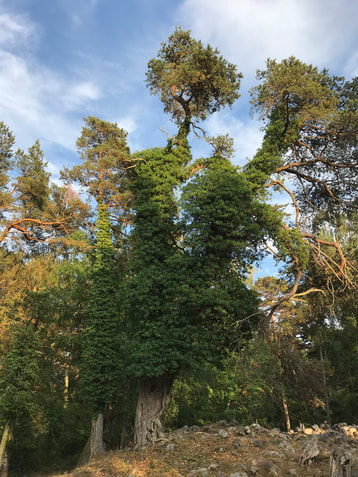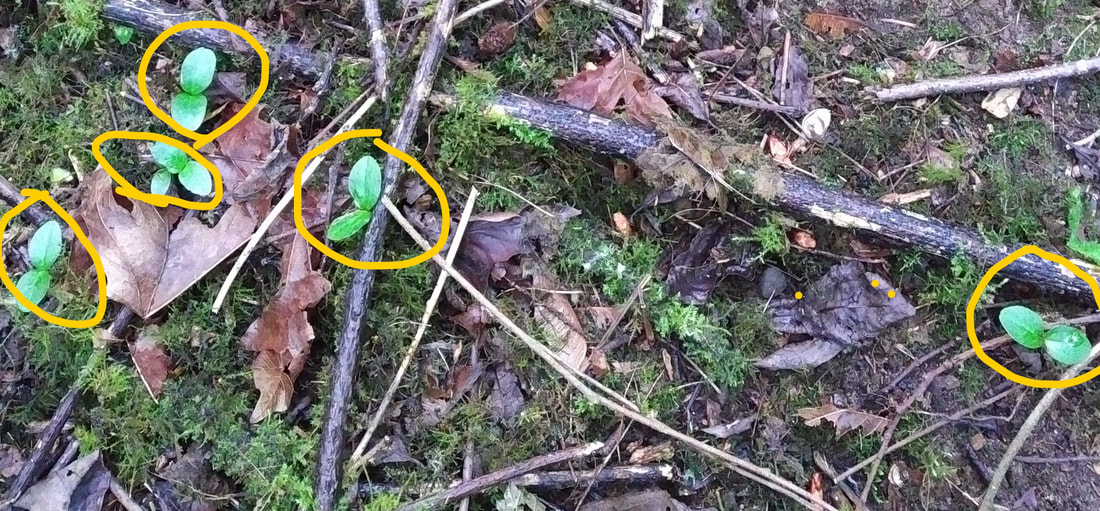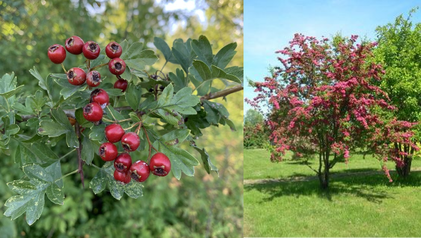The Problem
 English ivy strangling a madrone, a sail that can rot or topple trees. More worrisome, ivy sets seed when it climbs, speeding its spread. English ivy strangling a madrone, a sail that can rot or topple trees. More worrisome, ivy sets seed when it climbs, speeding its spread.
Pacific Northwest forests are threatened on many fronts: disease, exotic insects, droughts, and development. Catastrophic wildfires, recurring and intensifying, have certainly gotten our attention. However, the quiet spread of introduced (non-native) invasive plants has not received the same media attention, yet may have more lasting impacts. If we allow the spread of introduced species to become regionally entrenched, we may not recover from the loss of biodiversity and productive native habitat that sustains vital “eco-services,” such as clean water, air purification, flood control, carbon storage, wildlife habitat, and crop pollination, all critical to human health. Native plants are the basis of food webs that feed insects that in turn feed birds, fish, and wildlife. The food chain includes 4000 pollinator bee species native to North America that feed mainly on native plants, with some exceptions. When aggressive introduced plants displace diverse native plants, we lose redundant backups for plant pollination. Almost 90% of all plants require pollination to propagate. This includes crops, making native plant diversity a pillar of eco-services that sustain us.
West of the Cascades, both English holly and English ivy are germinating in normally weed-resistant forests. Ivy's slow, relentless spread can create "unstable" monocultures (prone to pests and disease), lacking the checks and balances needed for diverse, healthy habitat. Within 100 years, English ivy covered 50% of forests near urban epicenters and is now leapfrogging by bird into regional forests. If we don't act soon, "ivy deserts" could establish beyond our control. This could inhibit native plant regeneration, the foundation of biodiversity and all the resources we take for granted. Loss of native forests and biodiversity will affect quality of life, property values, flooding, landslides, forest resiliency, fisheries, bird and wildlife populations - all resources feeling the effects of colonial plant invasions. Bird diversity is linked to forest health, and songbird populations are critical components of stable ecosystems. The loss of biodiversity could also affect human health. English ivy is known habitat for rats, a disease vector and predator of bird nests. Other monocultures, like 40 million acres of grass lawns across the US, lack diversity needed for pollinators and butterflies, and instead attract pests requiring unnecessary pesticide control. Clearing land for monocultural crops may create conditions prone to "zoonotic" disease outbreaks in humans (https://www.scientificamerican.com/article/stopping-deforestation-can-prevent-pandemics1/). “The loss of biological diversity is an accelerating process with profound consequences for the ability of ecosystems to provide services to human societies. Ecosystem provision of services such as food production, water filtration, and protection against floods and droughts is reduced when biological diversity is lost. High biological diversity also is hypothesized to protect against human and wildlife diseases (Lyme disease, West Nile Virus, SARS, and Hantaviruses), and reduced disease spread or prevalence has been recognized as an ecosystem service.” (https://www.ncbi.nlm.nih.gov/pmc/articles/PMC2673579/) A foundation of biodiversity is plant diversity, therefore the spread of aggressive introduced plants poses unacceptable risks. Since 1974, insect abundance, critical to plant pollination has declined globally by 45 percent. Prevention is our best option and widespread cooperation is needed. Otherwise, the re-infestation rate of "seed rain" will nullify control efforts, risking ecological health and our economy. Already, one quarter of this country’s agricultural gross national product is lost each year to foreign plant pests and the costs of controlling them. "The massive, expanding costs of invasive species across the United States if left unchecked will continue unabated." |
Doug Tallamy is a professor of Entomology and Wildlife Ecology at the University of Delaware, focusing on eastern U.S. habitats. His plan for saving biodiversity, birds, pollinators, and ultimately humans applies everywhere, and can be found at: HOMEGROWN NATIONAL PARK.
|

